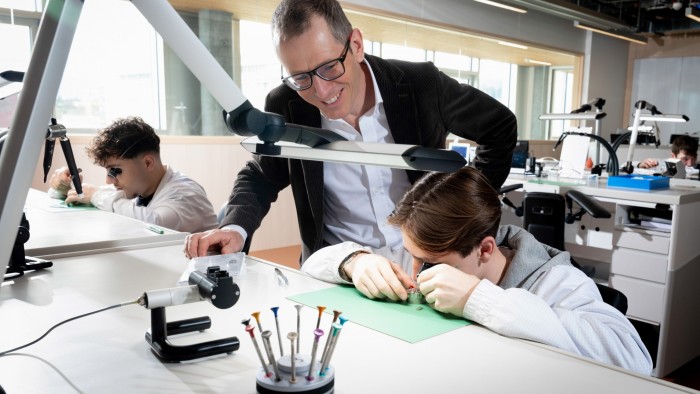Unlock the Editor’s Digest for free
Roula Khalaf, Editor of the FT, selects her favourite stories in this weekly newsletter.
Swiss timepiece sales might be on a downward spiral, but it seems there is still a healthy enthusiasm among teenagers to embark on careers in watchmaking and micro-mechanics.
“These days, even with the slowdown in the industry, we still receive many more applications than we can accommodate,” says Stéphane Cruchaud, head of the École d’Horlogerie de Genève (EHG), Switzerland’s oldest watchmaking school, which recently celebrated its 200th anniversary.
“Each year we have availability for 36 students to study watchmaking and 12 to study micro-mechanics, but those 48 places usually attract around 200 applicants,” he says. “There is slightly less interest when the overall economy dips, but the courses are always popular.”
Such is the importance of watchmaking to the Swiss economy that the courses are part of the CFC (Federal Certificate of Capacity) system that prepares young people to work in specific industries, with students starting their EHG studies at the age of 15 after leaving basic education.
Courses can be completed at schools such as the EHG (individual cantons often have their own) or on an apprenticeship basis with an approved watch company. The EHG is publicly funded by the canton of Geneva, meaning students are required to pay only SFr80 ($90) to cover the cost of the most basic materials, such as paper and other stationery.
“Only people whose parents pay taxes to the canton can study here, and the state pushes us to only take on people who have just finished their statutory schooling,” says Cruchaud. “That means most of the students are in the 15 to 18-year-old age range because the courses are either three or four years long.
“I would prefer to have a mixture of first-year students between the ages of 15 and 16, and 18 and 19, because, as a watchmaker, you need to be quiet, you need to be able to concentrate for long periods and you need to be focused. That is not always easy for someone who is still in their early teens.”
The courses, three years for basic watchmaking and four years for a more advanced qualification or to train as a “micro-mechanician” — which enables graduates to understand and operate the complex computer-controlled machinery used in horology and other manufacturing industries — sound intense.
During the first year, students don’t go near a watch movement, but learn how to make tools — such as screwdriver bits and hand-removing levers. They begin working on watch movements in year two, while year three is spent refreshing all the skills they need from stage one, learning how to work on more complicated movements and further reducing the manufacturing tolerances of finished components.
At the start of year three, students also embark on making a “school watch”, a relatively basic pocket timepiece or, if they are undertaking a fourth year — which equips them for restoration, production and aftersales work — a more complex wristwatch.
Some of the components for either type of watch can be created at the school, but since 2004 independent watch brand Chopard has supplied sets of other vital parts without which the students would not be able to create the school watches that they take away with them on completing their courses.
“During the course of more than 20 years, we have delivered 750 kits of between 70 and 80 components which allow each student to work on their own movement,” says Chopard co-president Karl-Friedrich Scheufele.
“The school previously used an old pocketwatch movement that we brought up to a far more modern standard using parts produced by our manufactures in Fleurier and Geneva. We have made enough to keep the school going for another 20 years.”
Now Chopard is marking EHG’s 200th anniversary with a series of 20 watches in its Heritage range with movements based on the type of calibre it supplies to the school.
Due to be unveiled this week at Watches & Wonders, the LUC Heritage EHG Moon 122 features a precision moonphase display that, if the watch is kept running, will not need to be corrected for 122 years. The aventurine dial depicts an interpretation of the night sky and the movement behind it is decorated to an ultra-high level.
The 44mm, rose gold watches will be offered to established collectors, while a small number of base moonphase movements will be made available for EHG students to complete, as well as for Chopard’s own graduating apprentices.
The idea to make these special watches arose in 2023 when the school was preparing to move from its site of 40 years at Lancy to new, state-of-the-art premises at Plan-les-Ouates, where some of Chopard’s operations are sited along with those of other blue-chip Geneva dial names such as Patek Philippe and Rolex.
The move, partly funded by the Hans Wilsdorf Foundation, the majority owner of Rolex, is set to enable the school to operate for decades to come — something that Scheufele believes is vital for the industry. “Schools like this are so important because we are all at the mercy of keeping up the traditions of fine watchmaking,” he says. “All of us in the industry have to be supportive of keeping these crafts alive.”
Guided tours of the EHG will be among the activities available during Watches and Wonders, on April 2, 3 and 4
Read the full article here

